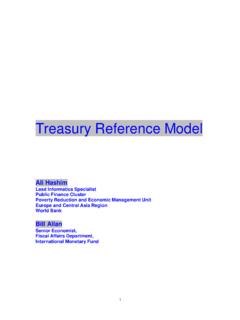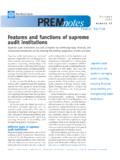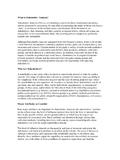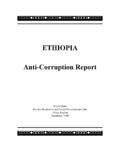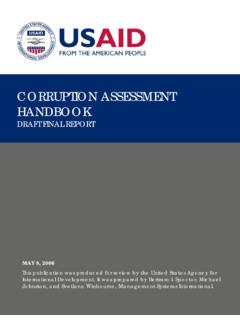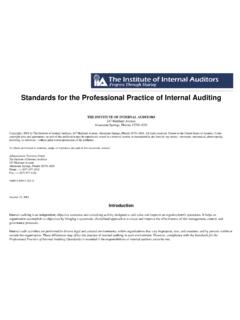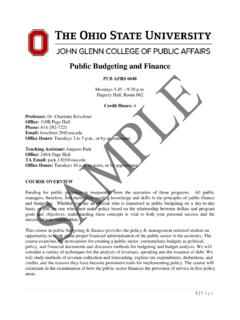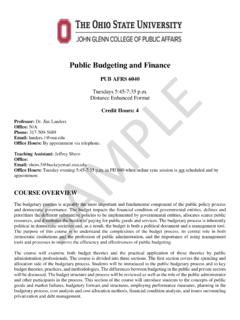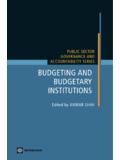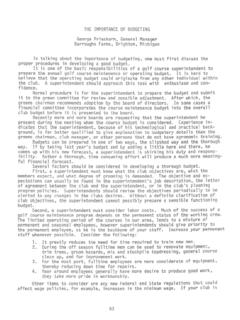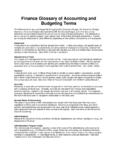Transcription of Chapter 4. THE BUDGET PREPARATION PROCESS A ... - …
1 Chapter BUDGET PREPARATION OF BUDGET PREPARATIOND uring BUDGET PREPARATION , trade-offs and prioritization among programs must bemade to ensure that the BUDGET fits government policies and priorities. Next, the mostcost-effective variants must be selected. Finally, means of increasing operationalefficiency in government must be sought. None of these can be accomplished unlessfinancial constraints are built into the PROCESS from the very start. Accordingly, thebudget formulation PROCESS has four major dimensions:1 Setting up the fiscal targets and the level of expenditures compatible withthese targets. This is the objective of preparing the macro-economicframework. Formulating expenditure policies. Allocating resources in conformity with both policies and fiscal targets. Thisis the main objective of the core processes of BUDGET PREPARATION .
2 Addressing operational efficiency and performance Chapter focuses on the core processes of BUDGET PREPARATION , and onmechanisms for aggregate expenditure control and strategic allocation of and performance issues are discussed in Chapter 15. Operational efficiencyquestions directly related to the arrangements for BUDGET PREPARATION are discussed inSection D IMPORTANCE OF A MEDIUM-TERM PERSPECTIVE FOR BUDGETINGThe need to address all three objectives of public expenditure management fiscaldiscipline, strategic resource allocation, and operational efficiency is emphasized inchapter 1. This calls for a link between policy and budgeting and for a perspectivebeyond the immediate course, the future is inherently uncertain, and the more so the longer the periodconsidered. The general trade-off is between policy relevance and certainty.
3 At oneextreme, government budgeting for just the following week would suffer the leastuncertainty but also be almost irrelevant as an instrument of policy. At the otherextreme, budgeting for a period of too many years would provide a broad context butcarry much greater uncertainty as In practice, multiyear means medium-term, , a perspective covering three to five years including the BUDGET , the feasibility in practice of a multiyear perspective is greater when revenuesare predictable and the mechanisms for controlling expenditure well- developed. ( , for example, has recently moved beyond a multiyear perspective to an outrightthree-year BUDGET for most budgetary accounts.) These conditions do not exist inmany developing , The dilemma is that a multiyear perspective is especiallyimportant in those countries where a clear sense of policy direction is a must forsustainable development, and public managers are often in sore need of somepredictability and dilemma that a multiyear perspective is especially needed where it is leastfeasible cannot be resolved easily, but must not be ignored.
4 On the one hand, to tryand extend the time horizon of the BUDGET PROCESS under conditions of severerevenue uncertainty and weak expenditure control would merely lead to frequentchanges in ceilings and appropriations, quickly degenerate into a formalistic exercise,and discredit the approach itself, thus compromising later attempts at the other hand, to remain wedded to narrow short-term management of publicexpenditure would preclude a move to improved linkage between policies andexpenditures. In practice, therefore, efforts should constantly be exerted to improverevenue forecasting (through such means as relieving administrative or politicalpressures for overoptimistic forecasts), and strengthen the linkages between policyformulation and expenditure, as well as the expenditure control mechanismsthemselves.
5 As and when these efforts yield progress, the time horizon for budgetpreparation can and should be lengthened. Because revenue-forecastingimprovements and the strengthening of policy-expenditure links and expenditurecontrol mechanisms are important in any event, efforts to achieve these can yield thedouble benefit of improving the short-term BUDGET PROCESS at the same time as theypermit expanding the BUDGET time horizon to take account of developmental , although in almost all countries government budgets are prepared on anannual cycle, to be formulated well they must take into account events outside theannual cycle, in particular the macroeconomic realities, the expected revenues, thelonger-term costs of programs, and government policies. Wildavsky (1986, p. 317)sums up the arguments against isolated annual budgeting as follows:short-sightedness, because only the next year s expenditures are reviewed;overspending, because huge disbursements in future years are hidden;conservatism, because incremental changes do not open up large future vistas;and parochialism, because programs tend to be viewed in isolation rather thanin comparison to their future costs in relation to expected , the annual BUDGET must reflect three paramount multiannualconsiderations: The future recurrent costs of capital expenditures; The funding needs of entitlement programs (for example debt service andtransfer payments) where expenditure levels may change, even thoughbasic policy remains the same.
6 Contingencies that may result in future spending requirements (forexample government loan guarantees (see Chapter 2).A medium-term outlook is necessary because the time span of an annual BUDGET istoo short for the purpose of adjusting expenditure priorities and uncertainties becometoo great over the longer term. At the time the BUDGET is formulated, most of theexpenditures of the BUDGET year have already been committed. For example, thesalaries of permanent civil servants, the pensions to be paid to retirees, debt servicecosts, and the like, are not variable in the short term. Other costs can be adjusted, butoften only marginally. The margin of maneuver is typically no more than 5 percent oftotal expenditure. This means that any real adjustment of expenditure priorities, if it isto be successful, has to take place over a time span of several years.)
7 For instance,the government may wish to switch from blanket provision of welfare services totargeted provision designed for those most in need. The expenditure implications ofsuch a policy change stretch over several years, and the policy therefore can hardlybe implemented through a blinkered focus on the annual spending projections are also necessary to demonstrate to theadministration and the public the desired direction of change. In the absence of amedium-term program, rapid spending adjustments to reflect changing circumstanceswill tend to be across-the-board and ad hoc, focused on inputs and activities that canbe cut in the short term. (Often, these are important public investment expenditures,and one of the typical outcomes of annual budgeting under constrainedcircumstances is to define public investment in effect as a mere residual.)
8 If theexpenditure adjustments are not policy-based, they will not be sustained. Byilluminating the expenditure implications of current policy decisions on future years budgets, medium-term spending projections enable governments to evaluate cost-effectiveness and to determine whether they are attempting more than they , in purely annual budgeting , the link between sectoral policies and budgetallocations is often weak. Sector politicians announce policies, but the BUDGET oftenfails to provide the necessary , two pitfalls should be avoided. First, a multiyear expenditure approach canitself be an occasion to develop an evasion strategy, by pushing expenditure off to theout-years. Second, it could lead to claims for increased expenditures from lineministries, since new programs are easily transformed into entitlements as soon asthey are included in the projections.
9 To avoid these two pitfalls, many developedcountries have limited the scope of their multiyear expenditures estimates to the costof existing programs, without making room for new programs. 6 Three variants of medium-term year expenditure programming can be considered: A mere technical projection of the forward costs of ongoing programs(including, of course, the recurrent costs of investments). A stringent planning approach, consisting of: (i) programming savings innonpriority sectors over the planned period, to leave room for higher-priority programs; but (ii) including in the multiyear program ongoingprograms and only those new programs that are included in the annualbudget currently under PREPARATION or for which financing is certain. Suchplans include only a few new projects beyond their first planned year ( ,the public Investment Program prepared in Sri Lanka until 1998).
10 The classic planning approach, which identifies explicitly new programsand their cost over the entire period. This includes development plans covering all expenditures, or many public investment programs currentlyprepared in several developing countries, as well as expenditure plansprepared in developed countries in the 1970s. Where the institutionalmechanisms for sound policy decision making and for budgeting are not inplace, this approach can lead to overloaded expenditure feasibility of implementing these different approaches and their linkages with theannual BUDGET depends on the capacity and institutional context of the specificcountry. However, the annual BUDGET should always be placed into some kind ofmultiyear perspective, even where formal multiyear expenditure programming is notfeasible. For this purpose two activities are a must: (i) systematic estimates of theforward costs of ongoing programs, when reviewing the annual BUDGET requests fromline ministries; (ii) aggregate expenditure estimates consistent with the medium-termmacroeconomic framework (see section C).
